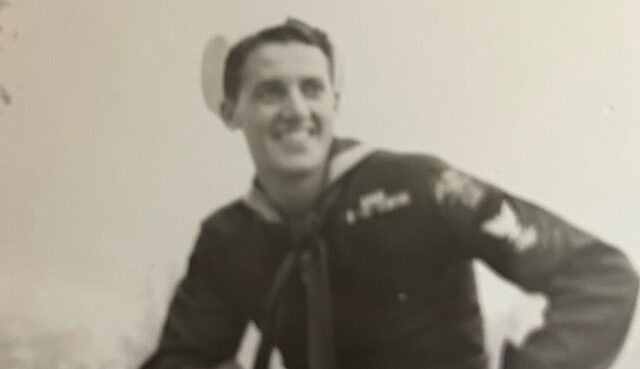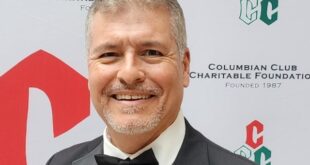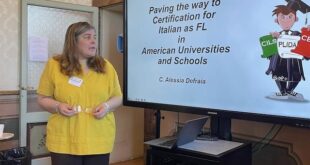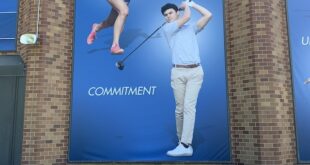A radioman on a Landing Ship Tank during World War II, Samuel Cascio and his crew delivered weapons, troops and other cargo throughout the Pacific.
The only son among four children, Dr. Samuel Cascio was born in Chicago on Aug. 27, 1924, to Joseph and Josephine (Guercio) Cascio. His father, a barber, was born in Baltimore, and his mother emigrated from Cefalù, Sicily, with her family.
Cascio grew up in the Portage Park neighborhood on the Northwest Side of Chicago with his maternal grandmother, aunt, uncle and cousins living two blocks away. He often brought his grandmother home for visits. “She would have a cane and I would hold her hand walking all that way,” Cascio says. “She just loved me for that.”
His mother made pasta with meat sauce on Sundays and Cascio especially liked her ravioli and sweet rolls. “My mother was a good cook and an excellent baker,” he says. “God bless her for that.”
Cascio graduated from Our Lady of Victory grammar school and went to St. Mel High School, where he participated in the ROTC program. To help pay for his tuition, Cascio delivered groceries at the local A&P grocery store, and was later promoted to cashier. Additionally, he was head usher and sold war bonds at the Portage Park Theatre. Cascio graduated in 1942 and began taking classes at St. Mary’s College in Winona, Minnesota.
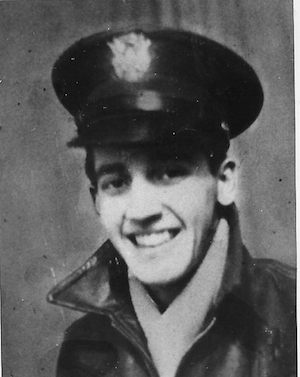 Five months later, he received his draft notice and, although he enjoyed the Army ROTC in high school, he decided to enlist in the Navy in April 1943. “Somehow, I liked the Navy because we’d be on a ship and I thought that was great,” Cascio says.
Five months later, he received his draft notice and, although he enjoyed the Army ROTC in high school, he decided to enlist in the Navy in April 1943. “Somehow, I liked the Navy because we’d be on a ship and I thought that was great,” Cascio says.
He completed basic training at Great Lakes naval station, where his ROTC training came in handy. Though he asked to be in the medical field, Cascio was assigned as a radioman. “They put you where they need you,” he says.
Cascio trained at Miami University in Ohio, first learning to type and then learning Morse code. “At first I didn’t like it, but then I did,” he chuckles. “It was a good way of learning. It had my mind going.” The Navy also ran a school for their cooks and bakers at the university. “So we used to eat pretty good,” Cascio says.
He completed training and was assigned to LST (Landing Ship Tank) 281 as a radioman, responsible for receiving all communications on the ship. Cascio deciphered and typed incoming messages/orders and delivered them to the captain, as well as sending outgoing messages. The LST and a crew of approximately 25 sailors shipped off down the coast from Norfolk, Virginia, and through the Panama Canal. Along the way, Cascio decoded a message with orders to pick up Marines and tanks at Pearl Harbor and deliver them to Okinawa, Japan.
The voyage took 25 days and the LST traveled in a convoy through the battlegrounds of the Pacific Ocean. “The destroyers and big ships were protecting us, basically,” Cascio says. “We did all right, under fire a couple of times but we used our 40-mm cannon guns and we were all right,” he continues. “We were lucky.”
As the only radioman on board, Cascio had a lot of responsibility and it was important that he was kept safe in his radio shack to receive and send vital wartime communications. “I didn’t see a lot of things, but I could hear it,” he says. “Most of the time they didn’t want me to do any gun work.” He chuckles as he remembers the pinup pictures of girls in their bathing suits decorating the walls of his shack.
In a lighthearted moment, the captain asked, “Sam, could you get music in my quarters?” “Not a problem,” Cascio replied. And he proceeded to wire up music for him.
The LST arrived safely in Okinawa, landed in the sand and opened its doors. “We did our job, tanks and Marines got out,” Cascio says. “We were done.” Two ships from the convoy that pulled into the harbor, one on either side of Cascio’s LST, got hit and suffered severe damage. “They couldn’t get out,” Cascio says. “We were fortunate to back out and get away from there.”
Island-hopping between the Philippines and Japan, Cascio witnessed the destruction of war. “We would get up in the ports and see nothing there,” he says. Towns lay in ruins and the people lost everything. When the ship arrived in ports, sailors threw their garbage in the water. “People were starving and they used to come out with little boats and pick up and eat the garbage,” says Cascio. “That’s why at home I would always say, ‘We don’t waste food in this house.’”
The LST stopped in Manila to pick up refugees from their bombed-out homes. “They were thrilled that we came,” Cascio says. “To me, we gave them nothing, but just to see us, I guess, they were thrilled.” The refugees lived on board the ship until they were transported to a different city in the Philippines. “I really felt sorry for them,” Cascio says. “We had to relocate them.”
Cascio was in Yokohama, Japan when the war in the Pacific ended. “I was elated when I heard that they signed the peace treaty because then I knew we would be going home,” he says. Cascio boarded a Cargo Troop Ship headed back to San Diego.
Cascio was honorably discharged from Great Lakes in April 1946 as Second Class Radioman, took a bus home and surprised his parents. “I rang the bell, my mother answered and she was crying,” Cascio remembers. “She said, ‘Thank God, he’s home!’ and she’s looking at me, ‘Are you hurt?’”
Under the GI Bill, Cascio continued at St. Mary’s College and earned a Bachelor of Science degree. Always interested in a career in the medical field, Cascio was thrilled to be accepted to Loyola University School of Dentistry, where he earned his doctorate in dental surgery. He drove a Checker Taxi while in dental school and was compelled to join the union.
Cascio enjoyed a successful 56-year career in his dental offices on the Northwest Side of Chicago. A leader in his profession, he is a past president of the Illinois State Dental Society, Chicago Academy of General Dentistry, Illinois Academy of General Dentistry, Loyola Dental Alumni Association, Progressive Club of the Chicago Dental Society and the Northwest Side Branch of the Chicago Dental Society.
He is well-known for humanitarian efforts on behalf of numerous organizations. Among many awards, he was named Humanitarian of the Year by the Italian American Executives of Transportation in 2018. He is a past president of the Columbian Club of Chicago and the Arcolian Dental Arts Society, and remains active in both organizations.
He married Rosemary Marino and they had four children. A widower, Cascio now counts 10 grandchildren and two great-grandchildren among his extended family.
Reflecting on his experience, he believes everyone would benefit from serving a year in the military to learn a different way of life and the value of money. “In my case I learned that,” Cascio says, “and I think it helped me mentally.”
The above appears in the October 2024 issue of the print version of Fra Noi. Our gorgeous, monthly magazine contains a veritable feast of news and views, profiles and features, entertainment and culture. To subscribe, click here.
 Fra Noi Embrace Your Inner Italian
Fra Noi Embrace Your Inner Italian


